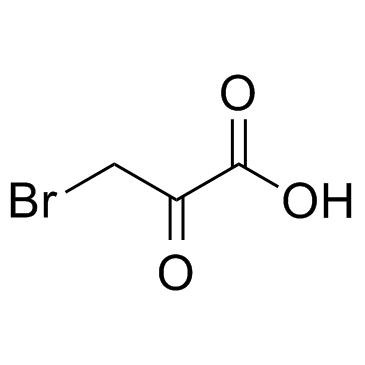3-Bromopyruvic acid

3-Bromopyruvic acid structure
|
Common Name | 3-Bromopyruvic acid | ||
|---|---|---|---|---|
| CAS Number | 1113-59-3 | Molecular Weight | 166.958 | |
| Density | 2.0±0.1 g/cm3 | Boiling Point | 223.4±23.0 °C at 760 mmHg | |
| Molecular Formula | C3H3BrO3 | Melting Point | 77-82 °C | |
| MSDS | Chinese USA | Flash Point | 88.9±22.6 °C | |
| Symbol |

GHS05 |
Signal Word | Danger | |
|
3-Bromopyruvate: A novel antifungal agent against the human pathogen Cryptococcus neoformans
Biochem. Biophys. Res. Commun. 434(2) , 322-7, (2013) Highlights • We examined the antifungal activity of 3-bromopyruvic acid (3-BP). • 3-BP could be a novel antifungal agent against Cryptococcus neoformans. • 3-BP acts on C. neoformans through fast depletion of intracellular ATP. • Its different uptake and accu... |
|
|
Inhibition of glucose turnover by 3-bromopyruvate counteracts pancreatic cancer stem cell features and sensitizes cells to gemcitabine.
Oncotarget 5(13) , 5177-89, (2014) According to the cancer stem cell (CSC) hypothesis, the aggressive growth and early metastasis of pancreatic ductal adenocarcinoma (PDA) is due to the activity of CSCs, which are not targeted by current therapies. Otto Warburg suggested that the growth of can... |
|
|
Insights into the carboxyltransferase reaction of pyruvate carboxylase from the structures of bound product and intermediate analogs.
Biochem. Biophys. Res. Commun. 441(2) , 377-82, (2013) Pyruvate carboxylase (PC) is a biotin-dependent enzyme that catalyzes the MgATP- and bicarbonate-dependent carboxylation of pyruvate to oxaloacetate, an important anaplerotic reaction in central metabolism. The carboxyltransferase (CT) domain of PC catalyzes ... |
|
|
Regulation of the proliferation of colon cancer cells by compounds that affect glycolysis, including 3-bromopyruvate, 2-deoxyglucose and biguanides.
Anticancer Res. 33(2) , 401-7, (2013) In previous studies performed by our group, we observed that 2-deoxyglucose blocked the acidification of the medium used for culture of colon cancer cells caused by incubation with biguanides and it had an additive inhibitory effect on growth. In the present ... |
|
|
Deprive to kill: glutamine closes the gate to anticancer monocarboxylic drugs.
Autophagy 8(12) , 1830-2, (2012) Killing properties of antitumor drugs can be enhanced by strategies targeting biochemical adaptations of cancer cells. Recently, we reported that depriving cancer cells of glutamine is a feasible approach to enhance antitumor effects of the alkylating analog ... |
|
|
3-Bromopyruvate (3BP) a fast acting, promising, powerful, specific, and effective "small molecule" anti-cancer agent taken from labside to bedside: introduction to a special issue.
J. Bioenerg. Biomembr. 44(1) , 1-6, (2012) Although the "Warburg effect", i.e., elevated glucose metabolism to lactic acid (glycolysis) even in the presence of oxygen, has been recognized as the most common biochemical phenotype of cancer for over 80 years, its biochemical and genetic basis remained u... |
|
|
Flow cytometric evaluation of the effects of 3-bromopyruvate (3BP) and dichloracetate (DCA) on THP-1 cells: a multiparameter analysis.
J. Bioenerg. Biomembr. 44(1) , 91-9, (2012) Two human leukemia cells K562 and THP-1, the breast cancer lines MCF-7 and ZR-75-1, and the melanoma line MDA-MB-435S were compared by flowcytometry for their behaviour at increasing levels of 3BP. K562 and THP-1 responded to 3BP by membrane depolarization an... |
|
|
Targeting aerobic glycolysis: 3-bromopyruvate as a promising anticancer drug.
J. Bioenerg. Biomembr. 44(1) , 17-29, (2012) The Warburg effect refers to the phenomenon whereby cancer cells avidly take up glucose and produce lactic acid under aerobic conditions. Although the molecular mechanisms underlying tumor reliance on glycolysis remains not completely clear, its inhibition op... |
|
|
Over-expression of GAPDH in human colorectal carcinoma as a preferred target of 3-bromopyruvate propyl ester.
J. Bioenerg. Biomembr. 44(1) , 117-25, (2012) It has long been observed that many cancer cells exhibit increased aerobic glycolysis and rely more on this pathway to generate ATP and metabolic intermediates for cell proliferation. Glyceraldehyde-3-phosphate dehydrogenase (GAPDH) is a key enzyme in glycoly... |
|
|
Regulation of death induction and chemosensitizing action of 3-bromopyruvate in myeloid leukemia cells: energy depletion, oxidative stress, and protein kinase activity modulation.
J. Pharmacol. Exp. Ther. 348(2) , 324-35, (2014) 3-Bromopyruvate (3-BrP) is an alkylating, energy-depleting drug that is of interest in antitumor therapies, although the mechanisms underlying its cytotoxicity are ill-defined. We show here that 3-BrP causes concentration-dependent cell death of HL60 and othe... |